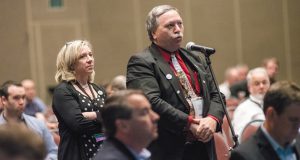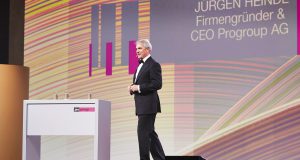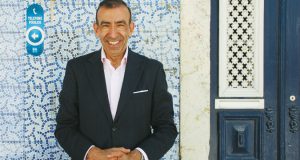Sustainable packaging is still an important concept as Ecologic prepares to relaunch.
GRAEME RODDEN
Founded in 2008 and repeatedly honored for its innovative packaging (e.g., the paper bottle) and business approach, Ecologic Brands has suffered through some growing pains, but is poised to make significant new breakthroughs in packaging design and technology with new investments.
 The company had about US$2 million in sales in 2015 in 10 countries. President and Founder Julie Corbett says Ecologic enjoys strong brand recognition and still holds “extensive global patents.” New capital and new manufacturing processes should be in place by mid-2017.
The company had about US$2 million in sales in 2015 in 10 countries. President and Founder Julie Corbett says Ecologic enjoys strong brand recognition and still holds “extensive global patents.” New capital and new manufacturing processes should be in place by mid-2017.
Ecologic is also looking at a big launch of a new product with a large consumer packaging group in 2017, adding that there is still a “waiting list” for the company’s products. The company is also looking at a significant sales increase. Exports in 2016 should account for about 40 percent of revenue and Corbett adds that Europe is a rapidly growing market. “It is a question of capital,” she notes.
What happened to the original business plan? Sometimes reality trumps a dream. In Ecologic’s case, Corbett explains that the organization was set up to increase sales; in theory, the manufacturing capability would follow soon after. It was the opposite of the noted movie Field of Dreams’ mantra: “Build it and they will come.”
But in the world of venture capital, money is not usually invested in manufacturing projects (compared with software, where fixes are relatively cheap.) “So, for packaging,” Corbett explains, “if bottles don’t show up on time or are not reliable or are not the right price, then you lose business. What happened to us was that reality hit. We were knocking on doors big time, but our resources were not focused on what was needed.”
One positive that came out of the efforts was that Ecologic was able to prove that its brand was viable. However, it was decided that a change at the top was necessary—from founder-based to professional management.
One of the company’s largest investors also had invested in an electric luxury car company. However, everyone rapidly discovered that, with a commodity-type product, the market won’t stand for a wait list, unlike a luxury car. “Your reputation is reliability and on-time delivery,” Corbett says.
Clearly, the professional management model did not work; there was too much overhead when a hands-on style was needed. In 2015, the company slashed its entire sales and marketing team to better focus on its manufacturing infrastructure. “That’s why we have been quiet for a year,” Corbett explains. “In August 2015, we needed to recapitalize and bring in new investors. I was the only survivor.”
CUP CONNECTION
Enter Greg Rodrigues, now CEO. In 1996, he started Insulair, which developed an insulated paper cup. McDonald’s restaurants thought so much of the product that the Insulair cup replaced all of the restaurant’s Styrofoam cups. In 2006, Georgia-Pacific purchased Insulair and made it part of the Dixie brand.
Rodrigues has been on the scene since 2011, when he was introduced to Corbett and joined Ecologic’s board. “I realized the challenges that she faced were similar to those at Insulair. You need to figure out the technology yourself;  professional management and outside consultants cannot do it.”
professional management and outside consultants cannot do it.”
However, the new management wanted to see more movement in sales, not technical advancement. “I was asked to leave the board in 2014,” Rodrigues says.
Rodrigues bided his time and, with the complete refocus in 2015, “I saw the opportunity and came in with a group of investors as well as injected my own money.”
Rodrigues became CEO and made the move to the site of the company’s headquarters and manufacturing facility in Manteca, CA, in December 2015. Corbett adds that since Rodrigues joined the team, the company has halted its “cash burn” and returned to Gross Margin Positive status.
“I saw this as similar to Insulair,” he notes. “The product is superior to those already on the market; it is revolutionary. We can sell it. We have good patents. We just needed the production facilities. We need the capex along with the proper technology.”
Rodrigues adds that some of the machinery has to be adapted to Ecologic’s needs; it cannot always be “off the shelf.” Once all is in place, estimated in early 2017, Rodrigues says the company will go back to the consumer product groups and “re-start the conversation. Our customers know that over time we will not be as high in costs.”
DESIGN REVOLUTION
Discussing Ecologic’s place in the market, Rodrigues cites industries such as large beverage makers that use glass bottles, cans, and plastic. “Each is not cost equivalent, but there is room for each. It’s the same for dairies: glass, plastic, and paperboard. We can be there as the environmental choice. We realize that we will never be as cheap as plastics.”
So what is Ecologic planning that will help it solidify its niche in the packaging marketplace? There are two main breakthroughs that cover both parts of its container: the outer fiber shell and the inner plastic pouch.
The former may be the most radical change. Ecologic is moving away from glue to bind the two sides of the container. It will use an interlocking system that should drop costs by about 80 percent and significantly speed up the process. Rodrigues says the process can produce up to 60 bottles per minute compared with the present 12 for most sizes.
 The new integration system is totally automated and was all Ecologic’s design. The seal is stronger than a glued one and the process is faster. It should be up in March/April 2017.
The new integration system is totally automated and was all Ecologic’s design. The seal is stronger than a glued one and the process is faster. It should be up in March/April 2017.
“It’s a revolutionary idea,” Rodrigues stresses. “It will be much more standardized because the system controls the substrate better. It takes away the disadvantage of paper flex (swelling, shrinking). This is a game changer for us.”
Ecologic can also ship shells to customers, as the integrators can be located at the customer’s site. There are various business models possible. “We have one European customer who makes the shells and pays us a royalty,” Rodrigues says. Ecologic can also ship just the shells or just the pouch.
Each bottle bears the Ecologic brand. The company has trademarked brands such as ecologic, Ecobottle, Ecocanister, and Eco.vintage. The lightweight plastic liner used ranges from HDPE to LDPE, No. 2 or No. 4. “This is a customer choice,” Rodrigues adds. “The brands also decide the shape of the bottle and the label.”
Both Corbett and Rodrigues are confident the relaunch will secure Ecologic’s place in a market that in the US totals 275 billion units: rigid plastic, glass, flexible fiber, and others. Eco-friendly containers can replace rigid plastic and glass, which account for 153 billion units. Of this, premium green units make up about 10 percent of the market, which is the Ecologic niche.
Over the years, Ecologic has signed supply agreements with some notable companies such as Nestlé/Purina, Safeway, 7th Generation, and European-based Rewe, which owns the private brand detergent Bipo and Australian-based Ecoplanet.
One of Ecologic’s most talked about products was the paper wine bottle. However, this is back on the shelf, so to speak, as there were quality problems. Corbett explains: “We could not deliver the quality or quantity and it cost too much.” However, with the new equipment, Corbett is confident the company can revisit this particular sector. “It will be done again; the technology is there.”
Container sizes vary; the most prevalent is the metric-sized 250-, 500- and 750-mL and 1-L bottles used for a variety of product areas: beverage, personal care, and home cleaning. These use a common production platform. The 250-mL and 500-mL containers can also be produced with a pump. Larger sized containers —1.5 and 3 L—are used for pet care, nutriceuticals, or nuts and grains. There are also Imperial sizes, 32 and 50 oz, used for home cleaning and home and garden products.
Corbett says Ecologic will be an “eco-premium brand” for the next two to three years. “Many consumer product groups are coming to us for eco-premium containers. As costs come down, then we can aim for the lower, wider base.
“It’s not how much you recycle, but what products you make from recycled material—this will be the true test of sustainability.”
Graeme Rodden is Paper360° senior editor, North and South America. Reach him at [email protected].
The Technology
Ecologic is a small operation. It uses only two tons/month of raw material, mostly OCC and some ONP, for which it has a reliable supplier of good quality fiber.
Fiber is loaded into a pulper. It is mostly a closed loop system, although some freshwater is added. A small amount of defoamer and a sizing agent are also added to the furnish. Retention time in the pulper is about 30 minutes at 5 percent consistency.
After storage there is a fine screening system and Ecologic tests for freeness and the amounts of OCC and ONP in the furnish. No optical brighteners are used.
In the forming/drying machine, there is a holding tank containing the slurry. The molds drop into the slurry. The molds raise and ports in the mold vacuum out excess water. The fiber sticks to the screens at the side of the mold. The molds rise up to fit the form, where heat and pressure remove the rest of the water and create a firm, smooth shell. The molding machine can make about one set per minute. In late 2016, Ecologic had six different molds for its products.
From here, the finished shells are conveyed to an integrator where the pouches are inserted and the sides glued, although this integration technology will be replaced in 2017.
ABOVE: The pulping system is mostly closed-loop.
ABOVE: A holding tank in the forming/drying machine contains the slurry; molds drop into the slurry.
RIGHT: Forming stage of bottle production.
 Paper 360
Paper 360


